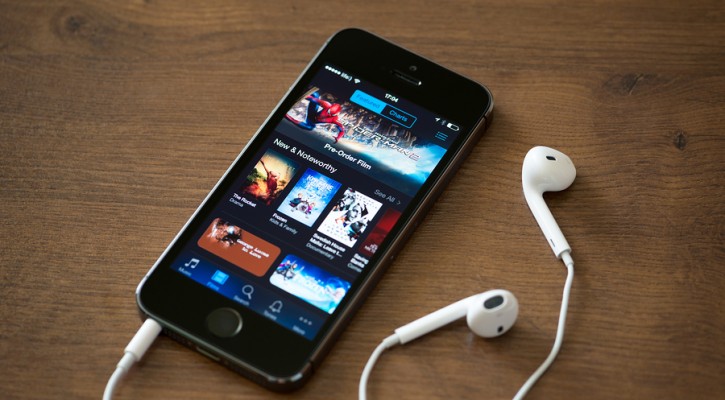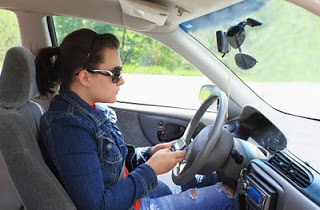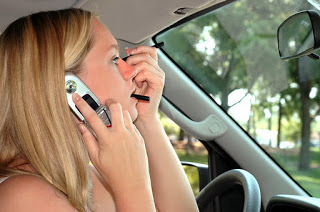Tag Archive: Distracted Driving

Earphones, Earbuds and Headphones While Driving
August 18, 2010
Since the invention of cars, drivers have had some sort of device to play music even if it was portable. Many years ago, when you drove your car, you only had the radio to listen to. The radio was proven to be a distraction even then. As technology progressed in vehicles, drivers had the option of having 8 tracks, cassette and then CD players installed in their cars. With today’s technology, tapes and CDs are an item for the history books. Now the major media devices are MP3 players and iPod’s. These small music players have the ability to hold someone’s entire music collection in a small “razor thin” electronic device. Now people can listen to their music on the go…anytime, anywhere, which has posed some problems.
In the last few years, manufactures have been installing inputs in vehicles that allow people to hook up their MP3 or iPod players. If you are not able to have a new car with an MP3 player connection it can be difficult to listen to your music. Lacking the proper connection, some drivers have turned to listening to their MP3 and iPod players through their earphones while driving their vehicles.
While driving any vehicle, using earphones presents many risks and is illegal in most states.
The most obvious reason this is dangerous is that you cannot hear what is happening around you. With headphones on, it becomes very hard to hear emergency vehicles, and other cars that might honk to alert you of a pedestrian, another vehicle or potential hazards. In addition, wearing headphones prevents you from hearing your own vehicle which may be making noises indicating a mechanical problem.
A final problem with using your MP3 player in your car is the potential distraction, even without the earphones on. Many iPod’s and MP3 players have enough storage space for your whole music collection. With a great amount of songs to select from, driver’s can be distracted scrolling through songs and picking the “perfect” driving playlist.
Not only is it illegal to wear headphones while driving a vehicle, but it is also illegal to wear them while riding a bicycle. Remember most states apply their driving laws to cyclists, which includes proper use of hand signals, lane obedience, etc. Many times a vehicle is not able to see bike traffic, so it is even more important cyclists hear cars and trucks.
If you do have an iPod or MP3 player and find it impossible to drive without your music, there are a few things you can do to make your drive a bit safer:
- If your vehicle does not have a MP3 or iPod hook up consider buying a FM transmitter or a cassette tape adapter. Both of these devices will enable you to play your music player through your stereo.
- In order to avoid becoming distracted while driving make up some playlists of your favorite songs, this way you will not be scrolling through your music collection trying to pick out songs you like.
- If you find that you have dropped or need to adjust your music player, find a safe place pull into. If you must pull of the road, pull all the away off and give yourself three feet of extra space margin away from the roadway. This will provide extra protection from a distracted driver who may drift into your lane and with give you a better view when you are ready to get back on the road.
By following these tips you can reduce your distractions and enjoy driving while listening to your favorite music.

Distracted Driving Campaigns
July 9, 2010
Buzz, buzz…it will just take a second to check. Ring, ring…it could be important. Yeah, I should go ahead and make that call. It will save me the time and hassle later on. The temptation to reach out and/or respond to some one through a cell phone is great. You have heard the news stories and safe driving campaigns and you know that you shouldn’t, but…do you resist the urge to use the cell phone or let temptation get the best of you?
In order to completely eliminate the urge to use your phone you could turn it off before turning your key in the ignition, lock it up (in the glove box, console, or trunk), or install some of the new technology for cell phones. There are several companies offering services that will restrict the phone’s ability to send and receive text and email messages. Some companies offer services that will restrict calls too. A sampling include:
Textecution – http://www.textecution.com
Textecution is an application designed for parents to install on their children’s phones. It utilizes the GPS features of several handsets to determine if the owner of the phone is moving at more than 10mph. It disables the texting function of the phone. If the person with Textecution on their phone is riding a vehicle as a passenger, or in a bus or train need to use the text feature, there is an “override” option — requesting for text access from the administrator. The parent who installed the phone is designated as the administrator, and can allow, temporarily for the phone to allow texting features. www.safefloridadriver.com
iZUP – http://www.getizup.com/
iZUP disables your phone entirely, removing any distraction from the road. It automatically forwards calls to voicemail and holds text messages while the phone is in motion. It is also time-delayed, to prevent reactivation of the phone’s features in natural stopping areas, like stop lights. The phone will only allow the user to make calls to 911 and 3 pre-approved numbers.
TXTBlocker – http://www.txtblocker.com/
TXTBlocker utilizes GPS locations to detect if the phone is traveling at a car’s moving rate and disables features of the phone accordingly. The installer of the TXTBlocker phone can also designate which areas are no-phone zones, and deactivates texting, calling, email and browsing. There’s also a feature that auto sends a text message to the parent, should the phone be moving at speeds greater than 65mph. Another safety feature for parents is they could check where the owner of the phone is in, based on GPS location. The phone will still be able to dial 911, in case of emergency. It only checks in with GPS every few minutes, so it doesn’t constantly use the phone’s battery.
DriveSafe.ly – http://www.drivesafe.ly/
DriveSafe.ly is a hands-free application that reads out text messages and emails as the phone receives it. There is an optional auto-responder that sends out a customized text message while the application is active.
Committing to be distraction free when you are driving is not easy. But the statistics remind us each day that we are more likely to have a collision when we are distracted, many drivers are making an effort. Regardless of whether it is hand held or hands free, the cell phone is a distraction for every driver.
Learn more about the Measures Taken to Stop Distracted Driving.

Reaching for Items in Your Vehicle and Distracted Driving
October 26, 2009
The hazard drivers create when they text or talk on cell phones has received considerable attention in the popular press recently. However, a more common distracted driving hazard is reaching for an item in the vehicle. Though cell phone use while driving is a significant problem, National Highway Traffic Safety Administration (NHTSA) studies indicate that it is a relatively small proportion of the distracted driving issue.
Driving distractions occur anytime something takes your eyes off the road, your hands off the steering wheel, or your mental attention from the task. Some distractions involve two or even all three of these. When you look for a particular song on a CD or MP3 player, your eyes turn from the road ahead, you remove at least one hand from the steering wheel, and you are temporarily preoccupied by the task of searching for the song you want to hear.
Other “reaching” distractions include:
- Eating
- Smoking
- Manipulating the controls of the aforementioned stereo, an in-vehicle navigation system or the climate control system
- Reaching for a fallen object
NHTSA estimates that drivers participate in potentially distracting activities about 30% of the time their vehicles are moving. Distraction may result in:
- loss of vehicle control
- unintended speed changes
- leaving the lane of travel
- missed opportunities to respond to changes in the driving scene
Though a motor vehicle crash caused by a driver reaching for something in the vehicle is not easily proved unless the driver admits to it, most drivers are aware of having driven while distracted by reaching for something in the vehicle.
“Reaching for something” does not have to mean reaching for an inanimate object. When they reach out to soothe, protect or discipline their children and pets, drivers’ attention is removed from the driving scene. Driving requires all your concentration, and parents should teach their children this and reinforce the lesson when necessary. Children should be fastened into appropriate safety restraint systems. While distractions aren’t good for you as a driver, they are great for children as passengers; DVDs, books, games, and small toys can keep them occupied until you reach your destination. If your children need attention, find a safe place to pull off the roadway. Your furry friend can travel safely in a pet carrier or safety harness. Never let your pet ride in your lap or roam around the vehicle while you drive.
Other ways to manage distractions include adjusting all of the vehicle’s controls before you start to drive and during stops at traffic lights, asking passengers to assist you when you need to get something inside your vehicle, and taking breaks to eat, drink and smoke.
Learning how to manage the distraction of reaching for things in your vehicle is a daunting task because it occurs so frequently. But doing so will allow you to keep you, your passengers, and other road users safe when you’re behind the wheel.

Teens and Distracted Driving
May 14, 2009
Car crashes are the number one killer of American teens, and the primary cause of fatal teen crashes is driver error. Driver distraction is included in the broad category of driver error. Though not every distracted teen driver is involved in a crash, distraction increases the risk of either causing a collision or being unable to avoid one. And though distracted driving is a problem for any driver, it is of special concern for inexperienced drivers, who may be distracted more easily and for longer periods of time and who may have difficulty controlling the vehicle even under normal conditions.
Modern diversions such as cell phones and other technical equipment are simply additions to traditional distractions such as eating, reading, dealing with passengers, reaching for objects, and looking at things or people outside of the vehicle. Dealing with passengers is one of the most frequently reported causes of distracted driving, and lively teen passengers can be particularly distracting to new drivers. Distracted driving is nothing new, but educational efforts to combat it are increasing.
It’s important to realize that when you’re driving, you’re already multitasking, because you are:
- Trying to control a large machine at high speed.
- Responding to the driving environment, including road and weather conditions, other traffic, and road signs and signals.
- Reacting to changing conditions, such as other drivers pulling out in front of you and pedestrians crossing the road ahead.
Adding another task to this list might be just enough to make you lose control of your vehicle or fail to act in time to prevent a collision.
The following tips will help prevent distracted driving:
- Increase your awareness of both physical and mental distractions. Physical distractions occur when you take your hands off the wheel and/or your eyes off the road. They happen when you adjust your stereo, take a drink of water, or reach for an object that has fallen on the floor. Mental distractions are sometimes more difficult to identify, because they don’t necessarily interfere with the physical act of driving. They occur when you argue or even laugh with a passenger, receive surprising or interesting news on your cell phone, or are preoccupied with a problem at school or work.
- Minimize the need for adjusting controls while you are driving. Take a few moments to prepare for your trip when you enter the vehicle. Adjust the seat position, climate control, stereo, and other devices before you leave your driveway or parking spot. If you are driving an unfamiliar vehicle, spend a few extra seconds locating the controls so you won’t need to look for them while you are driving.
- Review driving directions and maps, enter your destination into your navigation system and check traffic conditions before you leave. If you have a passenger, she or he can act as your navigator. Avoid sudden stop and turns while on the road by pulling over in a safe place, off the road and away from traffic, if you get confused or lost.
- Pull over to a safe place, off the road and away from traffic, to talk on the phone, text message or email. Using hands-free equipment is not safe enough because of the likelihood of mental distraction. Turn the phone off before you start out to reduce temptation.
- Stop at restaurants to eat or drink. Unwrapping food and condiment packages, reaching into bags, and having greasy fingertips are physical distractions. Realizing that you got the wrong sandwich is a mental distraction that is difficult to correct once you’ve left a drive-through window. Spilling coffee on your new shirt qualifies as both a physical and a mental distraction. Reduce your risk of a crash and your stress level by taking a few minutes to enjoy your meal outside of your vehicle.
- Keep in mind that your vehicle’s mirrors exist to help you view traffic, not yourself. Don’t use them for personal grooming while the vehicle is in motion.
As a driver, your only task when you enter your vehicle is to arrive safely at your destination. Anything else can be taken care of when you arrive. As a new driver, begin developing good habits right away by avoiding distractions and concentrating on your driving.
